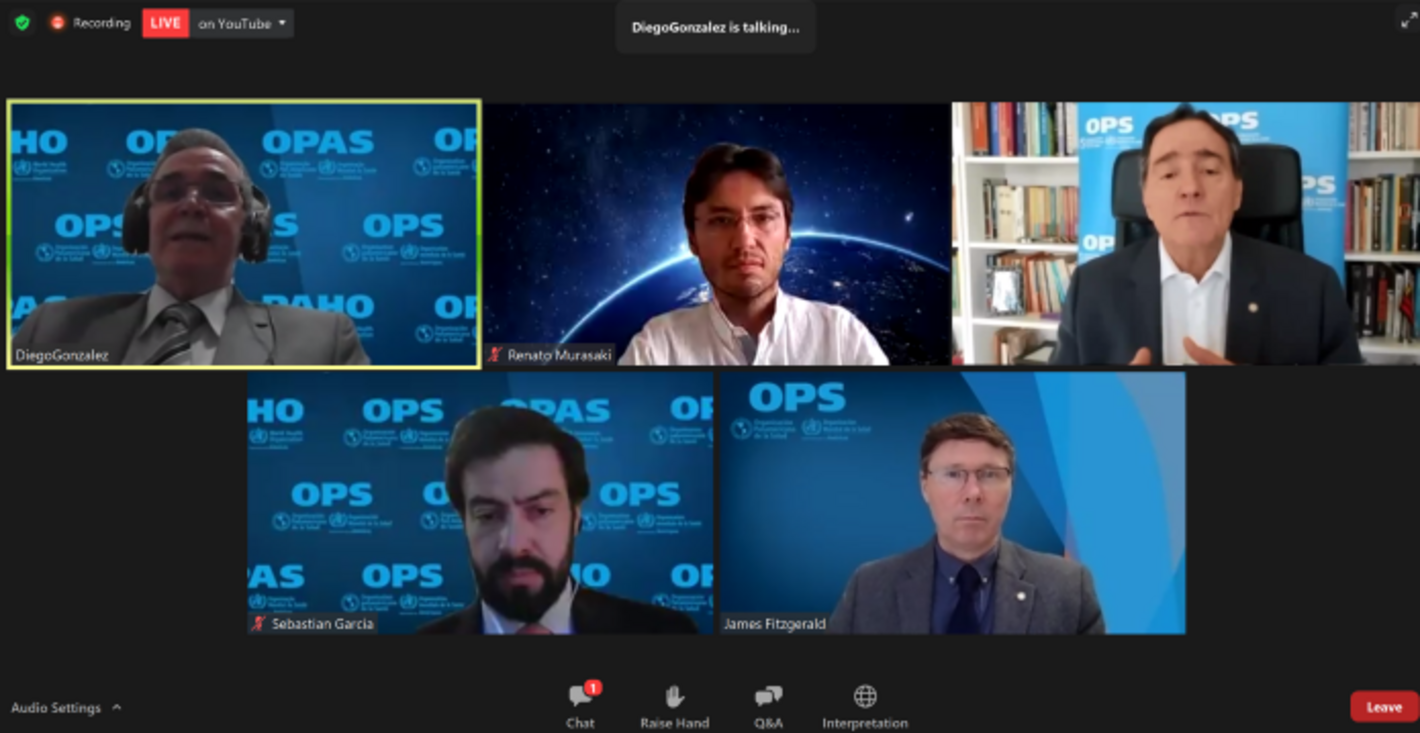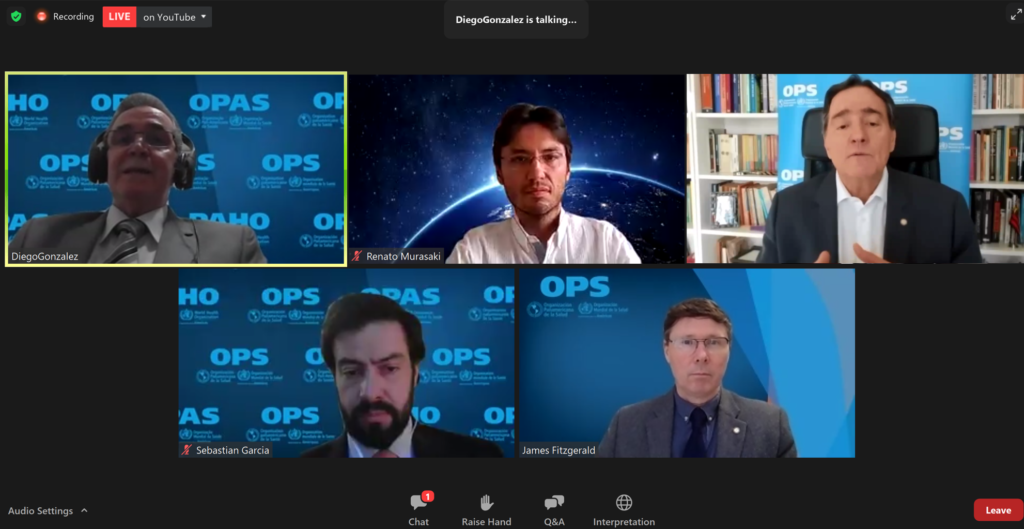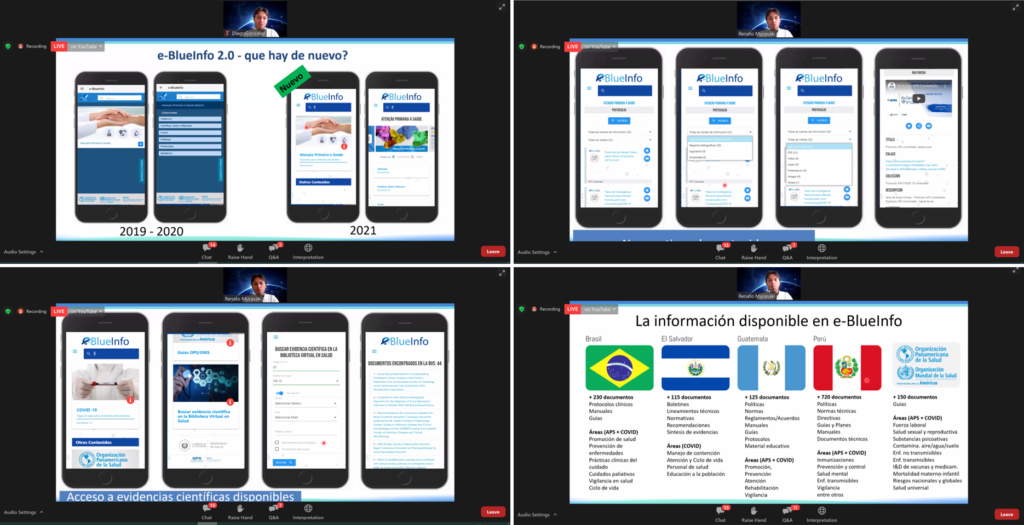
Originally launched[1] during the tenth edition of the Regional Congress on Health Sciences Information (CRICS10) in 2018, e-BlueInfo is an application available for Android and iOS systems that puts in the hands of health professionals reliable and up-to-date information selected by experts from Ministries of Health and educational and research institutions, in addition to including guidelines from the Pan American Health Organization/World Health Organization (PAHO/WHO) and scientific evidence available in the information sources of the Virtual Health Library (VHL).
Three years after the start of its development and adoption by Brazil, El Salvador, Guatemala, and Peru, BIREME launches the 2.0 version of the application, with new features and content. The online launch session took place on March 30 and was attended by PAHO/WHO personnel and representatives of the Ministries of Health of the participating countries.
Moderated by Diego González, Director of BIREME, the event was attended by more than 300 participants from 24 countries. In his opening statement, González spoke about the history of e-BlueInfo, inspired by WHO’s Blue Libraries, as a source of information for primary health care professionals. Next, he presented a video recorded by Jarbas Barbosa, Deputy Director of PAHO/WHO, which highlighted the role of the application in reducing inequity in access and use of information and scientific evidence in health, especially by health professionals and managers. In addition, he pointed out that the contents of the application have the contribution of local committees from Brazil, El Salvador, Guatemala, and Peru. Thus, through an easy-to-use technological solution, professionals have access to scientific information and evidence to support decision-making “in the palm of their hand”, produced by their own countries as well as by international organizations such as PAHO/WHO.
Although the application was created with a focus on primary care, the contents have been very timely in the management of Covid-19 cases. Congratulating BIREME on the initiative and the Ministries of Health of the countries for joining the program, Jarbas Barbosa expressed his wish for other countries to join the network.
James Fitzgerald, Director of the PAHO/WHO Department of Health Services, then talked about “Resilience of Health Systems.” In his statement, Fitzgerald presented an overview of the context of Covid-19 and the development of resilient health systems in the Americas.
The 2016 PAHO/WHO Resolution CD55.R8 Resolution on Resilient Health Systems states: “Recognizing that resilience is a critical attribute of a well-developed and well-performing health system whereby health actors, institutions, and populations prepare for and effectively respond to crises, maintain core functions when a crisis hits, and, informed by lessons learned, reorganize if conditions require it”.
Based on this premise, Fitzgerald gives an overview of the devastating effects of the Covid-19 pandemic in the Americas regarding health, economic, and social aspects. Moreover, he shows, in the Organization’s vision, the necessary steps for the countries of the Region to build – individually and collectively – resilient health systems in the post-pandemic world. He further emphasized the need to strengthen human resources in health and information systems, to which mobile applications such as e-BlueInfo can contribute.
Renato Murasaki, Manager of Information Methodologies and Technologies at BIREME, coordinator of the team responsible for the development of the application, spoke about the innovations of version 2.0.
Expressing solidarity to the victims of the pandemic and acknowledging health professionals, Murasaki also recognizes the coordination of the Ministries of Health, the support of PAHO/WHO Representatives, and the contribution of the network of educational and research institutions in the participating countries. The 2.0 version being released today has been planned, discussed, and agreed upon for about a year with the e-BlueInfo Regional Steering Committee. Google Analytics statistics from a week ago show that there were more than 5,500 app downloads in the four countries that adopted e-BlueInfo.
On the new features of version 2.0, Murasaki showed that the changes go beyond a new interface. There are new collections of documents; greater visibility of sources from Ministries of Health (through logos); new graphics and data of interest to users; information for health professionals from countries that are not yet part of the e-BlueInfo network (the ‘other countries’ option); collections of guidelines published by PAHO/WHO; access to scientific evidence available in the VHL using the codes of the International Classification of Diseases (ICD-10); related scientific and technical information available in the VHL; and new types of content, such as multimedia, health legislation, etc. In addition, version 2.0 of the application offers the option of storing the user’s favorite and visited documents (through authentication).
Murasaki concluded his presentation by showing the characteristics of the content of the participating countries and PAHO/WHO available so far, such as the number and types of documents and areas of primary care represented in the application, as well as documents on Covid-19, if there are any. Thanking the Management Committees of the Ministries of Health of the countries and the PAHO/WHO Offices for their support, Renato recognized the work of his team, BIREME as a whole, and the Knowledge and Evidence Translation team of the EIH Department in obtaining the results that were presented in this release.
Next, the representatives of the Ministries of Health of the countries that are part of the e-BlueInfo network made their presentations.
Brazil was represented by Renata de Oliveira Costa, Director of the Department of Family Health, of the Secretariat of Primary Health Care, speaking on behalf of the Secretary of Primary Health Care of the Ministry of Health, Raphael Câmara Medeiros Parente. Thanking PAHO and BIREME for their partnership, Renata highlighted this important moment for science and primary care. The SAPS/MS representative reiterated the Secretariat’s support for the production of knowledge and reliable information for decision making. He also pointed out that the pandemic surfaced weaknesses in the health system that can become more efficient with contributions such as this application.
Next, Xochitl Sandoval, Director of the National Institute of Health of the Ministry of Health of El Salvador, expressed his satisfaction that his country is part of the e-BlueInfo network, built through interactions with health and research institutions and PAHO/WHO. The health information ecosystem provided not only by the application, but by the VHL Network, has been used in El Salvador intensively. A health information exchange was established between institutions and professionals, which greatly benefited the country. El Salvador incorporated information about Covid-19 into the documents available on e-BlueInfo since the beginning of the pandemic and this action was subsequently adopted by other countries. The INS is currently preparing the inclusion of new content that will be of great use to health professionals. He wishes the initiative every success, and that other countries join the e-BlueInfo network.
Fernando Carbone, Advisor to the Ministerial Office of the Peruvian Ministry of Health, spoke next, representing the Minister of Health. Peru was the second country after Brazil to join the application in 2019. He mentions the crisis in the health system caused by the pandemic in 2020, which catalyzes a paradigm shift, focusing on digital tools and innovative technologies. Primary care, in particular, finds in these technologies a space to be spread at national level. In 2020, the National Multisectoral Health Policy was built, a multiministerial initiative together with academia, civil society, and the productive sector, in which health information is available through the e-BlueInfo application. In addition, telemedicine in Peru has partnered with e-BlueInfo to make the contents on telehealth available in the application. Carbone concludes by expressing his wish that more countries will join the initiative to follow what was agreed at the International Conference on Primary Health Care in Alma-Ata[2], in 1978.
Closing the countries’ contributions, Edwin Montúfar, Deputy Minister of Primary Care, Ministry of Public Health and Social Assistance of Guatemala, representing the Minister of Health, reports that Guatemala has participated in the initiative since December 2019. With the support of the academic community, the Ministry of Health provided documents about Covid-19 in the application, which was of great use to health professionals, researchers, and students, as well as in coping with the pandemic. The application has also allowed us to improve equity in access to information for decision making, and helps us decentralize regulatory processes. We hope that other countries will join the initiative, which for Guatemala was a watershed in Primary Health Care.
Finally, Sebastián Garcia Saisó, Director of the EIH Department, at the end of the session, spoke of the implications of the release of version 2.0. The Director of EIH spoke about the context of the pandemic and the need to strengthen the countries’ health systems (citing Fitzgerald). By referring to the digital tool that supports decision-making by providing current and reliable information “in the palm of the hands” of healthcare professionals, this translates into a real-time response to communities. It is not just a tool, but an integrated system that gathers information from a database such as the VHL, plus documents selected by the Ministries of Health of the countries, as well as recommendations from international organizations such as PAHO and WHO. It is a way to give voice to all instances of a country – government, academia, society, local committees – and close gaps. It is PAHO’s contribution in countries for a digital transformation in the field of health.
The incorporation of technologies in the health sector was slower than in other sectors – finance, industry – but Covid-19 propelled this transition. IS4H is an example of this.
The Director of EIH concluded his intervention with the following statement: “this launch promotes the construction of a digital environment with the participation of all to make better health decisions. Congratulations to all who participated in its development and to all who have adopted it”.
Visit the app’s website for more information: https://e-blueinfo.bvsalud.org/
Recording of the virtual release session of version 2.0 is available on the YouTube Channel.
[1] BIREM Bulletin n° 28. e-BlueInfo: information in the palm of the hand. Available at: https://boletin.bireme.org/en/2019/01/28/e-blueinfo-information-in-the-palm-of-the-hand/ (Accessed on April 2nd 2021)
[2] World Health Organization. International Conference on Primary Health Care, Alma-Ata. Available at: https://www.who.int/publications/almaata_declaration_en.pdf (Access on April 2nd 2021)







